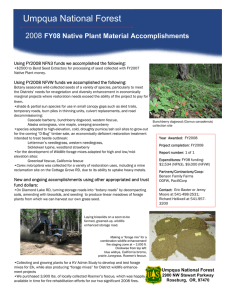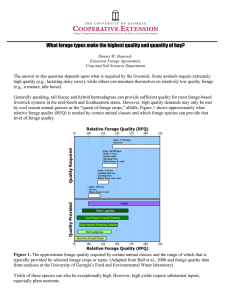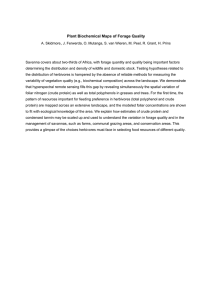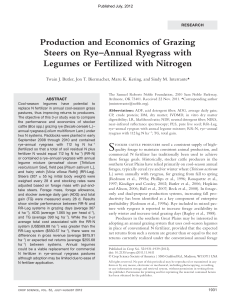UNIVERSITY OF GEORGIA College of Agricultural and Environmental Sciences
advertisement
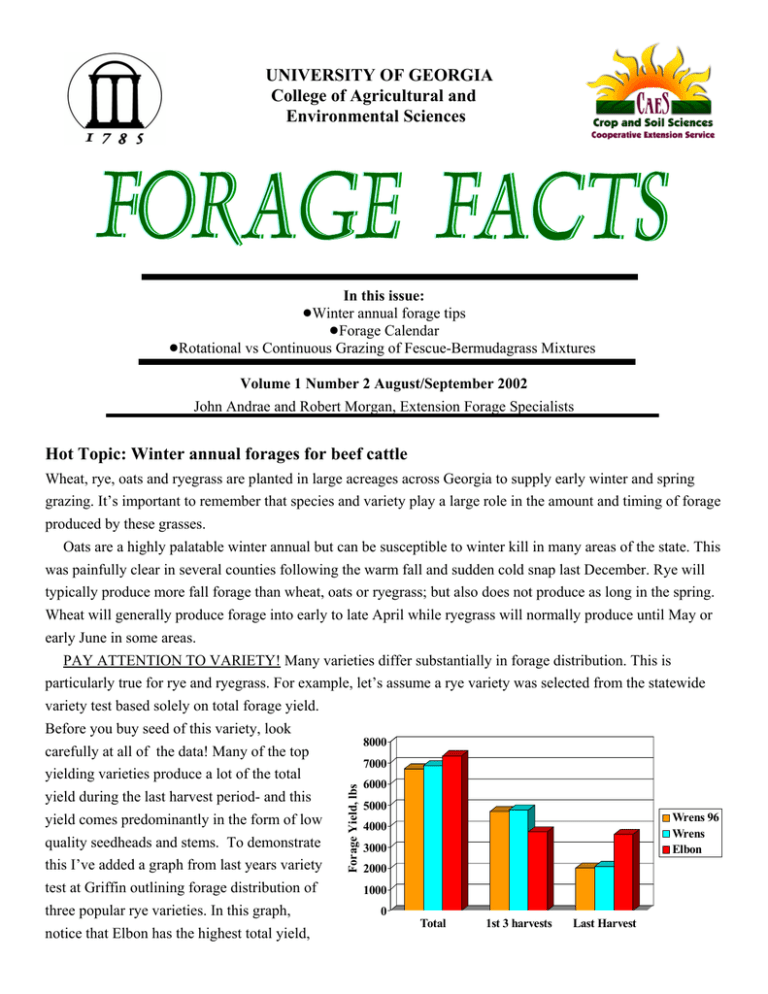
UNIVERSITY OF GEORGIA College of Agricultural and Environmental Sciences In this issue: !Winter annual forage tips !Forage Calendar !Rotational vs Continuous Grazing of Fescue-Bermudagrass Mixtures Volume 1 Number 2 August/September 2002 John Andrae and Robert Morgan, Extension Forage Specialists Hot Topic: Winter annual forages for beef cattle Wheat, rye, oats and ryegrass are planted in large acreages across Georgia to supply early winter and spring grazing. It’s important to remember that species and variety play a large role in the amount and timing of forage produced by these grasses. Oats are a highly palatable winter annual but can be susceptible to winter kill in many areas of the state. This was painfully clear in several counties following the warm fall and sudden cold snap last December. Rye will typically produce more fall forage than wheat, oats or ryegrass; but also does not produce as long in the spring. Wheat will generally produce forage into early to late April while ryegrass will normally produce until May or early June in some areas. PAY ATTENTION TO VARIETY! Many varieties differ substantially in forage distribution. This is particularly true for rye and ryegrass. For example, let’s assume a rye variety was selected from the statewide variety test based solely on total forage yield. Before you buy seed of this variety, look 8000 carefully at all of the data! Many of the top 7000 yield during the last harvest period- and this yield comes predominantly in the form of low quality seedheads and stems. To demonstrate this I’ve added a graph from last years variety test at Griffin outlining forage distribution of three popular rye varieties. In this graph, notice that Elbon has the highest total yield, Forage Yield, lbs yielding varieties produce a lot of the total 6000 5000 Wrens 96 Wrens Elbon 4000 3000 2000 1000 0 Total 1st 3 harvests Last Harvest but yields less forage than either Wrens variety when only the first three harvests (when forage need is more critical) are considered. Robert Morgan and I have worked with the small grains team and variety testing program to break out the first of the production season in the statewide variety test reports. This should help farmers determine what varieties produce forage early in the season when it is needed for grazing. To the best of my knowledge, Georgia is the first state to break out rye forage production data in this manner. This should be extremely helpful in making variety decisions for forages. Please use this data from the statewide variety test to your advantage! Ryegrass varieties can also differ substantially in production. This is particularly true for common ryegrass (also known as ‘Gulf’ or ‘Oregon’ ryegrass). Improved varieties can yield much more forage than Gulf and if rust is an issue in your area an improved rust resistant cultivar like Jackson can be used. Last year the cost of common ryegrass was about $16 per bag and improved varieties were normally in the $18 range. This amounts to $1 per acre difference. Yield results from Alabama indicate that improved varieties yield about 15% higher than Gulf sources. For more information on small grain overseeding, read the Georgia Cattleman article I wrote last fall on the subject. Go to www.georgiaforages.com and search the Georgia Cattleman archives. There is also a link at that site to the latest forage variety test information. Forage Calendar: Prepare for sprigging NEXT years bermudagrass fields. This is particularly important if common bermudagrass must be controlled or if soil pH is low. Sample and evaluate current fields for weed control, tillage and fertility needs. It is also time to reserve good winter annual grass and clover varieties for overseeding, start planning to overseed white or red clover in tall fescue, begin stockpiling tall fescue or bermudagrass, and finalize plans for alfalfa seedings. It’s a busy time of year for forage producers! Abstract of the Month: Rotational vs continuous stocking of beef cows and calves on mixed endophyte-free tall fescuebermudagrass pasture. C.S. Hoveland, M.A. McCann, and N.S. Hill. J. Prod. Agric. 10:245-250. Endophyte-free tall fescue furnishes better animal performance than endophyte-infected grass but is less persistent under grazing, especially in mixture with common bermdagrass. Rotational compared with continuous stocking of endophyte-free tall fescue may improve persistence when grown with an aggressive warm season perennial grass. Four 40 acre bermudagrass pastures were no-till seeded with endophyte free tall fescue, allowing two repications to compare grazing methods. Rotationally stocked pastures were divided into 12 paddocks to allow 2 d grazing and 22 d rest. Twenty beef cows per 40 ac pasture were maintained year round for 3 yrs with additional cows added in spring and summer to maintain similar forage availability. Grazing method had no effect on cow weight change, pregnancy rate, or calf weaning weight. Pasture stocking rate and calf weaning weight per acre were 38 and 37% higher and winter hay consumption was 31% lower from rotationally stocked pastures because of better tall fescue persistence and forage availablity. Crude protein and in vitro dry matter digestibility generally exceeded 8 and 50%. Rotational stocking appears to be useful in maintaining stands of endophyte free tall fescue in bermudagrass pastures.


